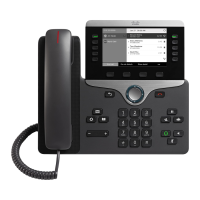






Do you have a question about the Cisco 8811 and is the answer not in the manual?
| Ethernet Ports | 2 x 10/100/1000 |
|---|---|
| Lines Supported | 5 |
| Speakerphone | Yes |
| Headset Port | Yes |
| USB Port | No |
| Bluetooth | No |
| Wi-Fi | No |
| Resolution | 800 x 480 pixels |
| PoE | Yes, IEEE 802.3af Class 2 |
| Audio Codec Support | G.711, G.722, G.729, iLBC |
| Protocols | SIP |
| Display | 5-inch, 800 x 480 pixels |
| Headset Jack | RJ9 |
| Weight | 1.1 kg |
Explains accessibility features for vision, hearing, and mobility impaired users.
Overview and specifications for various Cisco IP Phone models.
Energy-saving modes for the phone display and power consumption.
Links to Cisco website for more resources and guides.
Instructions for attaching and adjusting the phone's adjustable footstand.
Procedure for adjusting the handset rest for wall-mounted phones.
Guidance on using a cable lock to secure the phone to a desk.
Covers dialing, answering, and basic call functions like redialing.
Details on call holding, transferring, forwarding, and muting calls.
Explains how to pick up calls, answer waiting calls, and manage multiple calls.
Managing video during calls, including showing/hiding video and adjusting settings.
Searching and dialing contacts from the corporate directory.
Managing personal contacts, adding entries, and dialing.
Setting up and using fast-dial codes for quick calling.
Making calls via a web browser interface.
Understanding how call history is displayed and interpreted.
Steps to view, detail, filter, and clear call history entries.
Procedures for accessing and checking voice messages.
Using the visual voicemail interface for message management.
Adding parties to calls, joining calls into conferences, and managing participants.
Using speed-dial buttons and codes for efficient calling.
Enabling and disabling the DND feature to manage incoming calls.
Configuring the phone for temporary use with a different profile.
Using mobile phones to handle desk phone calls.
Pairing mobile devices and tablets for enhanced phone features.
Viewing and managing running applications on the phone.
Connecting to the corporate network remotely via Expressway.
Using a tool to report phone problems and collect logs.
Configuring the phone for VPN use with Mobile and Remote Access.
Customizing the phone's background wallpaper.
Selecting different ringtones for incoming calls.
Adjusting screen brightness and contrast levels.
Modifying character display size for readability.
Accessing special phone features and web-based information.
Steps for mounting the camera on phones or monitors.
Operating the physical lens shutter to block video.
Setting user preferences for auto-transmit, brightness, and view area.
Overview of supported Cisco and third-party accessories.
Connecting and charging mobile devices via USB ports.
Configuring wideband settings for analog headsets.
Pairing, connecting, and using Bluetooth headsets.
Adding, connecting, turning on/off, disconnecting, and deleting Bluetooth accessories.
Features and operation of the Cisco IP Phone 8800 Key Expansion Module.
Why all active calls might not be visible on the phone screen.
FAQs on redirecting, silencing, resuming calls, and button differences.
Explanations for why softkeys change and how to manage calls on shared lines.
How to handle accidental button presses and exit applications.
FAQs on combining calls and canceling transfers/conferences.
Explanations for phone not waking up and ring patterns.
Solutions for missing Alert Calls or All Calls buttons on the phone.
Troubleshooting sign-in problems for Expressway and personal directory.
Addressing security error messages and reporting phone problems.
General safety guidelines, power outages, and external device recommendations.
Information on Bluetooth performance and interference.
Statements regarding FCC rules for radiation and digital devices.
Details on hardware warranty and services.
